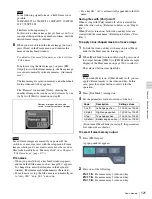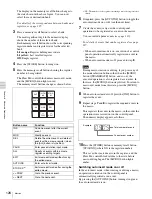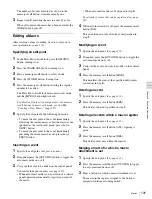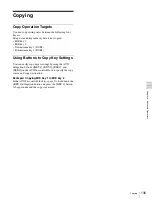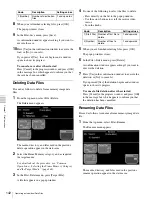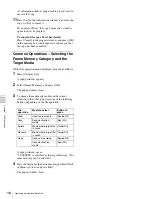
Ch
ap
te
r
6
A
d
v
a
nc
ed
O
p
er
at
io
ns
129
Macros
When the [AUTO INS] button lights in orange (this mode
is off), it is necessary to press the [INS] button for each
operation to register the event.
Note
When you start macro creation or editing with the macro
execution mode set to “Normal”
, the auto
insert mode is automatically on. When “Step” is selected
as the macro execution mode, the auto insert mode is
automatically off.
Creating a pause event
To create a pause event, use the following procedure.
1
Press the memory recall button [PAUS].
The Flexi Pad control block enters pause duration
input mode, and the memory recall buttons appear as
in the following figure.
2
Enter the pause duration (0 to 999 (frames)).
If you set the duration to “0,” macro execution will be
paused at the position of this pause event.
3
Press the [PAUS ENTR] button.
This sets the pause duration, and inserts the pause
event.
appearance The appearance of the memory recall
buttons returns to the before execution of step
1
.
Events requiring adjustment when creating a
macro
The following event requires time for execution to
complete, and therefore when executed within a macro
sequence, a pause event must be inserted to adjust the
timing.
• VTR/disk recorder/Extended VTR cue up
For a macro to cue up a VTR and then play back, for
example, a pause event must be inserted between the cue
up event and the playback event.
To include all information associated with an
operation when registering a macro event
When registering an auto transition operation as an event,
you can register the auto transition event to include the
transition rate and background A/B bus selection status.
To use this capability, assign the following functions to
buttons in the utility control block, and turn the relevant
button on before you start an event to register.
Macro AT with Rate (Macro Auto Trans Event with/
without Rate):
When registering an auto transition
macro event, include the transition rate.
Macro AT with A/B Bus (Macro Auto Trans Event
with/without A/B Bus):
When registering an auto
transition macro event in the transition control block,
include the background A/B bus cross-point.
For details of the method of assigning these functions to
buttons, see “Utility Settings (Utility Menu)” (page 170).
Recalling a Macro Register and
Executing a Macro
There are two macro execution modes.
Normal execution mode:
When execution of an event is
completed, the next event is executed automatically.
Step execution mode:
When execution of an event is
completed, macro execution is paused.
You can switch the normal execution mode and step
execution mode in the Setup menu. See “Macro Execution
Mode Settings (Macro Menu)” (page 175).
When a macro is paused at a pause zero event or when a
macro is paused in step execution mode, restarting such
macro is referred to as a “macro take operation.”
7
8
9
4
5
6
1
2
3
0
CLR
PAUS
ENTR
Summary of Contents for MFS-2000
Page 6: ...6 Table of Contents ...
Page 136: ...Chapter 6 Advanced Operations 136 Copying ...
Page 192: ...192 Other Settings Chapter 9 System Settings ...
Page 198: ...198 Index Index ...







